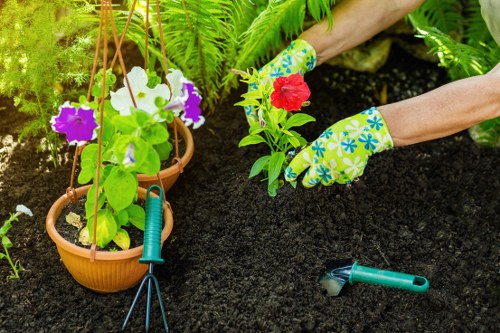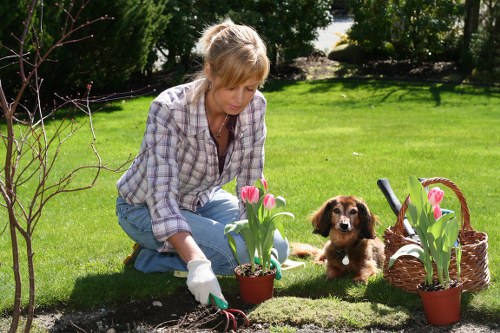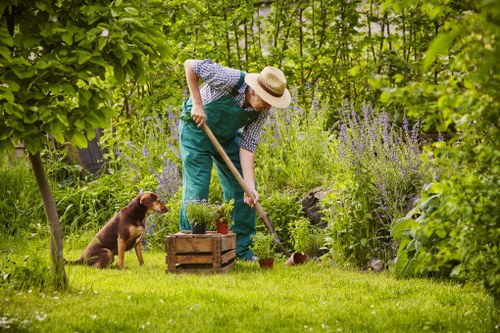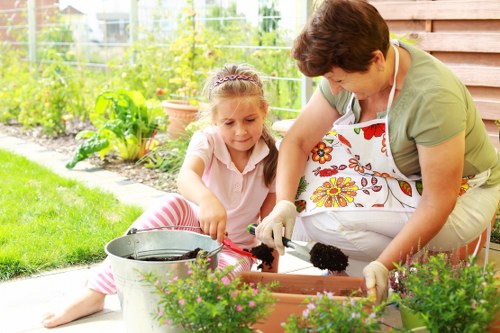Landscaping in Garden Maintenance
Importance of Landscaping in Garden Maintenance

Landscaping plays a crucial role in garden maintenance, enhancing both the beauty and functionality of outdoor spaces. A well-maintained landscape not only boosts the visual appeal of a property but also contributes to the overall health of the environment.
Effective landscaping involves a combination of aesthetic design and practical maintenance practices. It requires a deep understanding of plant biology, soil health, and climate conditions to create a harmonious and sustainable outdoor space.
Moreover, landscaping can significantly increase the value of a property, making it an essential aspect of home maintenance and real estate investment.
Enhancing Aesthetic Appeal

One of the primary benefits of landscaping is the enhancement of a property's aesthetic appeal. Through thoughtful design and plant selection, landscaping can transform a plain yard into a stunning garden that reflects personal style and preferences.
Features such as flower beds, shrubs, trees, and water elements like fountains or ponds can add layers of interest and beauty to a garden. Additionally, the use of color, texture, and form in plant selection can create visually appealing contrasts and harmonies.
Well-designed landscapes also provide practical benefits, such as creating shaded areas for relaxation, defining outdoor living spaces, and improving the overall curb appeal of a home.
Promoting Environmental Health

Beyond aesthetics, landscaping contributes to the environmental health of an area. Plants play a vital role in air purification by absorbing carbon dioxide and releasing oxygen. They also help in reducing noise pollution and providing natural habitats for various species of fauna.
Proper landscaping can aid in water management by preventing soil erosion and promoting groundwater recharge. The strategic placement of plants and the use of mulch can significantly reduce runoff, thus conserving water and protecting local waterways.
Additionally, landscaping with native plants supports biodiversity and ensures that the garden is resilient to local pests and diseases, reducing the need for chemical interventions.
Key Elements of Effective Landscaping

Creating an effective landscape requires careful consideration of several key elements that work together to form a cohesive and sustainable garden.
- Plant Selection: Choosing the right plants that thrive in the local climate and soil conditions is fundamental.
- Soil Preparation: Ensuring the soil is fertile and well-draining supports healthy plant growth.
- Water Management: Implementing efficient irrigation systems conserves water and maintains plant health.
- Maintenance Practices: Regular pruning, weeding, and pest control keep the garden in optimal condition.
- Design and Layout: Thoughtful arrangement of plants and garden features enhances functionality and beauty.
Plant Selection

Selecting the appropriate plants is a cornerstone of successful landscaping. It involves understanding the hardiness zones, sunlight requirements, and water needs of various plants to ensure they thrive in the given environment.
Incorporating a mix of evergreen and deciduous plants can provide year-round interest, while flowering plants add vibrant colors during specific seasons. Additionally, considering the mature size of plants prevents overcrowding and ensures that they have adequate space to grow.
Using native plants is highly recommended as they are adapted to the local climate and soil, making them more resilient and less demanding in terms of maintenance.
Soil Preparation
Improving Soil Quality
The foundation of a healthy garden lies in the quality of the soil. Proper soil preparation involves testing soil pH, adding necessary amendments, and ensuring good drainage.
Incorporating organic matter such as compost or well-rotted manure enriches the soil with essential nutrients and improves its structure. This promotes better root growth and enhances the overall vitality of plants.
Regularly aerating the soil can prevent compaction, ensuring that plant roots receive adequate oxygen and water. Mulching also plays a vital role in retaining moisture, suppressing weeds, and regulating soil temperature.
Seasonal Landscaping Practices
Maintaining a beautiful garden requires adapting landscaping practices to the changing seasons. Each season presents unique challenges and opportunities to enhance and preserve the landscape.
- Spring: Focus on planting new vegetation, pruning overgrown plants, and preparing soil for the active growing season.
- Summer: Implement efficient watering schedules, manage pests, and provide shade for plants and outdoor spaces.
- Fall: Conduct thorough cleanups, prepare plants for winter, and plant seasonal flowers.
- Winter: Protect sensitive plants from frost, maintain garden structures, and plan for the next year's landscaping projects.
Spring Maintenance
Spring is the time for rejuvenation and preparing the garden for the growing season. Key activities include:
- Planting: Introduce new plants, perennials, and annuals to refresh the garden's appearance.
- Pruning: Trim back dead or overgrown branches to promote healthy growth.
- Soil Preparation: Add compost and fertilizers to enrich the soil and support plant health.
Addressing these tasks in spring sets the stage for a flourishing garden throughout the year.
Summer Care

Summer brings its own set of challenges, particularly in managing water usage and coping with heat stress. Implementing efficient irrigation systems, such as drip irrigation, ensures that plants receive adequate moisture without wastage.
Providing shade through strategic plant placement or the use of shade cloths helps protect sensitive plants from scorching temperatures. Regular monitoring for pests and diseases is also essential to maintain plant health during the hot months.
Mulching remains an important practice in summer, as it conserves soil moisture and regulates temperature, creating a more stable environment for plant roots.
Fall Cleanup
As temperatures begin to drop, fall cleanup becomes a priority to prepare the garden for winter. Key tasks include:
- Removing Debris: Clear away fallen leaves, dead plants, and other debris to prevent mold and pests.
- Planting Bulbs: Introduce spring-blooming bulbs to add color in the coming year.
- Protecting Plants: Apply mulch around perennials and shrubs to insulate roots against freezing temperatures.
These practices ensure that the garden remains healthy and ready to thrive in the next growing season.
Sustainable Landscaping Practices
Embracing sustainability in landscaping not only benefits the environment but also enhances the resilience and longevity of the garden.
Water Conservation
- Irrigation Systems: Installing rain sensors and drip irrigation minimizes water wastage.
- Rainwater Harvesting: Collecting and storing rainwater reduces dependence on municipal water supplies.
- Mulching: Retains soil moisture and reduces the need for frequent watering.
Native Plants
Benefits of Native Flora
Incorporating native plants into landscaping has numerous advantages. These plants are naturally adapted to the local climate, requiring less water and maintenance. They also provide habitats for native wildlife, promoting biodiversity.
Native flora are more resistant to local pests and diseases, reducing the need for chemical interventions and contributing to a healthier garden ecosystem.
By focusing on native species, gardeners can create a sustainable and low-maintenance landscape that thrives with minimal human intervention.
Professional vs DIY Landscaping
When it comes to landscaping, homeowners often face the decision of whether to hire professionals or take a do-it-yourself (DIY) approach. Both options have their merits and can be chosen based on individual needs, budget, and expertise.
Advantages of Hiring Professionals
- Expertise: Professionals bring specialized knowledge and experience, ensuring high-quality results.
- Efficiency: They have the necessary tools and resources to complete projects promptly.
- Design Skills: Professional landscapers can create customized designs that enhance the property's unique features.
When to DIY
Opting for a DIY approach can be beneficial for smaller projects or for those who enjoy hands-on gardening. Benefits include:
- Cost Savings: DIY landscaping can be more affordable as it eliminates labor costs.
- Personal Satisfaction: Completing projects personally can be rewarding and allow for creative expression.
- Flexibility: Homeowners can work at their own pace and make changes as desired.
Ultimately, the choice between professional and DIY landscaping depends on the scope of the project, available time, and personal preferences.
Conclusion

Landscaping is an integral component of effective garden maintenance, offering both aesthetic and environmental benefits. By understanding the key elements of landscaping, such as plant selection, soil preparation, and sustainable practices, gardeners can create and maintain beautiful, resilient outdoor spaces.
Whether opting for professional services or embracing a DIY approach, investing in landscaping ensures that gardens remain vibrant, functional, and harmonious with the surrounding environment.
Embrace the art and science of landscaping to transform your garden into a sanctuary that reflects personal style and supports ecological balance.
Ready to transform your garden?
Contact us today to learn more about our professional landscaping services and start your journey towards a beautiful and sustainable garden.